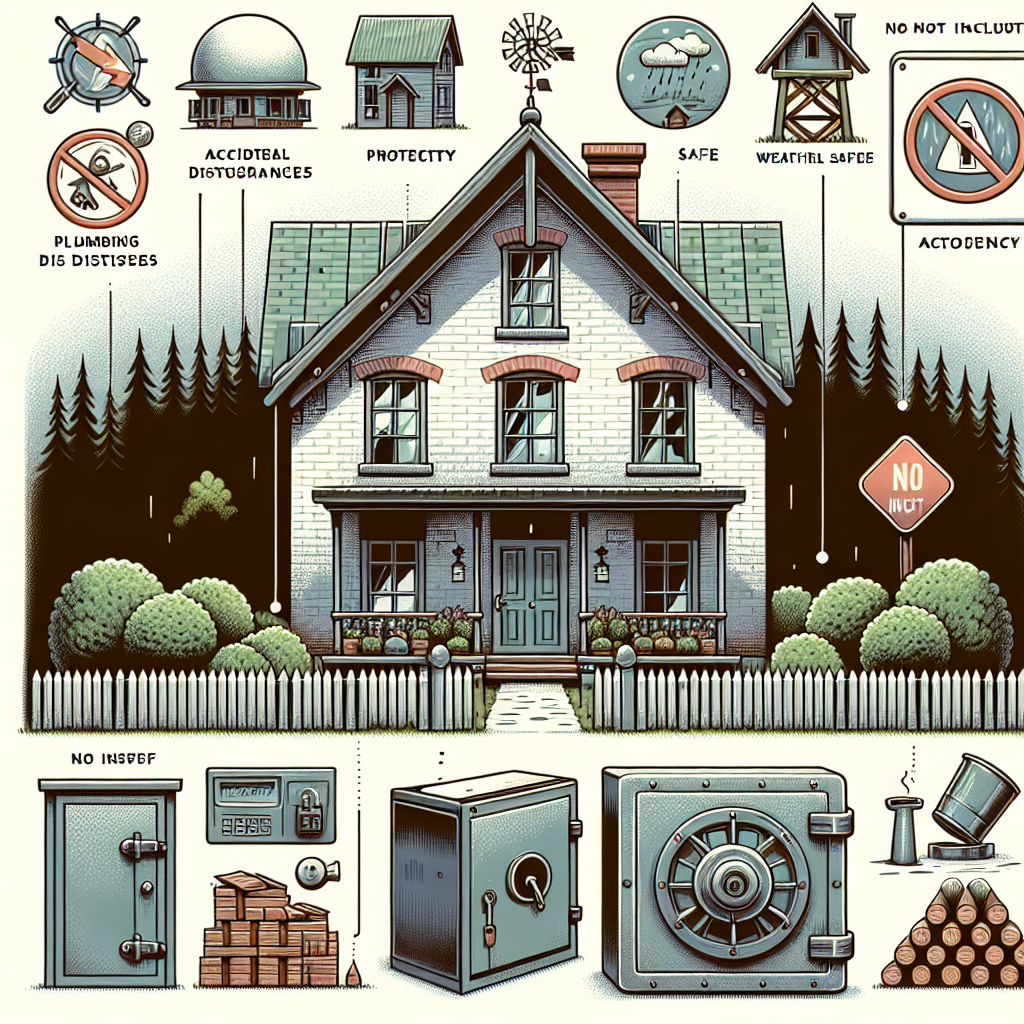Filed under Home Insurance on
Progressive Home Insurance Coverage Explained

Shopping for homeowners insurance is not just about finding the lowest premium. It is about aligning your policy with the way you live, the home you own, and the risks you face. If you are looking at Progressive Home Insurance Coverage, you are considering a widely recognized brand that offers home policies through a network of affiliated and partner insurers. This guide breaks down what is typically covered, what is not, how to customize protection, and how to avoid costly gaps while keeping premiums in check.
What Progressive Home Insurance Coverage generally includes
Homeowners policies share a common backbone across the industry. While details vary by state and underwriting company, the following core protections are standard in most packages offered under the Progressive umbrella.
Dwelling coverage
This protects the structure of your home itself: walls, roof, built-in appliances, flooring, and attached structures such as an attached garage. The limit should reflect the full cost to rebuild your home at today’s prices, not its market value. That figure is influenced by square footage, construction type, finishes, and local labor and materials costs.
Other structures
Fences, sheds, detached garages, and gazebos typically fall under this coverage. The limit often defaults to a percentage of your primary dwelling coverage but can be adjusted if you have substantial detached structures.
Personal property
Your belongings, from furniture and electronics to clothing and cookware, are covered against named perils such as fire or theft. You can choose actual cash value (depreciated) or replacement cost coverage (which replaces with new items of like kind and quality). High-value items like jewelry, art, and collectibles may require scheduled coverage.
Loss of use
If a covered loss makes your home uninhabitable, this pays for temporary living expenses such as hotel stays, short-term rentals, restaurant meals, and increased transportation costs, subject to your policy limits.
Personal liability
Liability protects you if you are found legally responsible for injury to others or damage to their property. It covers legal defense and settlements or judgments up to your limit for covered claims. Many homeowners opt for at least 300,000 dollars; 500,000 dollars is common for higher net-worth households or those with elevated risk factors. You can layer a personal umbrella policy above this for additional protection.
Medical payments to others
This is a no-fault coverage that pays for minor injuries to guests who are hurt on your property, regardless of liability, typically in smaller increments such as 1,000 to 5,000 dollars or more depending on your selection.
Popular add-ons that close common coverage gaps
Optional endorsements can tailor your policy more precisely to your home and lifestyle. Many of these are available on policies placed via Progressive, though availability varies by state and underwriting company.
- Water backup and sump overflow: Pays for damage from water that backs up through sewers or drains or overflows from a sump pump. Standard policies generally exclude this without an endorsement.
- Service line coverage: Helps with the cost to repair or replace underground utility lines you own, such as water or sewer lines, from the street to your home.
- Equipment breakdown: Covers sudden mechanical or electrical breakdown of systems like HVAC, appliances, and smart-home devices beyond normal wear and tear.
- Extended or guaranteed dwelling replacement: Provides a buffer—often a stated percentage above your dwelling limit—for reconstruction cost spikes after a major loss.
- Ordinance or law: Pays extra costs to bring your home up to current codes after covered damage when local law requires upgrades.
- Replacement cost on personal property: Upgrades your belongings coverage from depreciated value to new-for-old replacement.
- Scheduled personal property: Increases limits and often broadens causes of loss for high-value items such as engagement rings, fine art, musical instruments, and camera gear.
- Matching siding or roof: Helps replace undamaged portions of materials so repaired areas match the rest of your home, subject to policy terms.
- Green rebuilding: Offers coverage for eco-friendly materials or upgrades when rebuilding after a loss.
- Cyber or identity theft: Assists with expenses related to identity restoration or certain cyber incidents.
- Home-sharing or short-term rental: Addresses exposures when you rent part or all of your home through platforms. This is not standard and must be endorsed if available.
It is wise to review add-ons annually. Building costs, personal collections, and risks evolve. Over time, you may outgrow basic coverage and benefit from a more robust Progressive Home Insurance Coverage package tailored to your situation.
What homeowners policies typically exclude
Understanding exclusions is half the battle. The most common surprises occur when a loss falls into one of these buckets.
- Flood: Rising water from storm surge, river overflow, or heavy rain is excluded under standard homeowners insurance. Flood coverage can be purchased separately through the National Flood Insurance Program or private carriers.
- Earthquake and earth movement: Earthquakes, sinkholes, and land shifts are not covered unless you add a specific endorsement or buy a separate policy.
- Maintenance and wear and tear: Gradual deterioration, rot, and mold due to neglect or deferred maintenance are excluded.
- Sewer backup: Not covered without the water backup endorsement mentioned above.
- Infestations: Damage from termites, rodents, and pests is generally excluded.
- Business activities: Running a business from home may require endorsements or a separate policy, particularly for inventory and liability.
- Intentional acts and illegal activities: Losses stemming from intentional damage or unlawful conduct are excluded.
- Certain dog breeds or animal liability limitations: Some insurers limit coverage for specific breeds or exotic pets. Review your policy for any animal liability exclusions or sublimits.
While exclusions can feel daunting, most can be addressed by adding endorsements or pairing your homeowners policy with complementary coverage. A careful reading of Progressive Home Insurance Coverage details, including endorsements and state-specific forms, will clarify what is available to you.
How much coverage do you need?
Picking the right limits is part math, part judgment. Here is a structured way to approach it.
Calculate an accurate dwelling limit
- Reconstruction cost, not market value: Ask your agent to run a replacement cost estimator that accounts for your home’s square footage, roof type, exterior finish, interior upgrades, and local building costs.
- Account for code upgrades: If you own an older home, ordinance-or-law coverage is important because code-required upgrades add cost during repairs.
- Consider extended replacement: In regions prone to catastrophes, labor and material costs often spike after an event. An extended replacement buffer can help prevent underinsurance.
Set realistic personal property limits
A standard starting point is 50 to 70 percent of the dwelling limit, but the right number comes from your inventory. Walk room to room and record major items and serial numbers. Consider replacement cost on contents to avoid depreciation surprises.
Choose a liability limit with your future in mind
Liability is inexpensive relative to the protection it provides. If you own a dog, host frequent gatherings, have a pool, or possess significant assets, a higher liability limit and an umbrella policy can be prudent and affordable.
Deductibles, wind and hail, and named storm considerations
Most policies allow you to select an all-perils deductible. In coastal and severe weather regions, there may be a separate deductible for wind or hail, sometimes expressed as a percentage of the dwelling limit for hurricanes or named storms. Understand these details before a storm is on the radar.
Pricing, trends, and why premiums are changing
Home insurance rates have shifted markedly over the past few years. Industry sources such as the Insurance Information Institute and major reinsurers have underscored a convergence of factors:
- Climate and catastrophe losses: More frequent and severe wind, hail, wildfire, and convective storm events have driven higher claim costs.
- Reconstruction inflation: Labor shortages and supply chain volatility have pushed up the price of materials and skilled trades, raising the cost to rebuild.
- Reinsurance dynamics: The cost of insurers’ own protection has increased, and those costs can flow through to consumers.
- Localized underwriting pressure: Certain states face tighter eligibility rules due to catastrophe exposure and legal environments, which may limit options and raise premiums.
Against this backdrop, policyholders benefit from accuracy and mitigation. A precise dwelling limit, risk-informed deductibles, and targeted endorsements can prevent unpleasant surprises. Many insurers that work with Progressive also recognize mitigation—from new roofs and impact-resistant materials to monitored security systems and water shutoff devices—often with credits or discounts.
Ways to save without weakening protection
Price matters, but cutting essential coverage is a false economy. Consider these strategies, many of which are commonly available when purchasing through Progressive’s platform or its affiliated home insurers:
- Bundle home and auto: Multi-policy discounts are often substantial. Bundling can also simplify billing and policy management.
- Fortify your home: Roof updates, impact-resistant shingles, secondary water barriers, and modern electrical and plumbing upgrades can earn credits and reduce losses.
- Smart-home and security devices: Monitored alarms, smoke detectors, water leak sensors, and automatic water shutoff systems can reduce risk and may qualify for discounts.
- Increase your deductible thoughtfully: A higher deductible can significantly lower premiums. Ensure the amount fits your emergency fund.
- Claim-free history: Remaining claim-free over time can earn loyalty or loss-free discounts. Consider whether small losses are worth filing.
- Pay in full and go paperless: Administrative discounts are commonplace for electronic document delivery and full-pay options.
- Right-size personal property coverage: Conduct an inventory so you are not over- or underinsuring contents. Add scheduled items for high-value property rather than raising limits across the board.
Reviewing and refreshing your Progressive Home Insurance Coverage at renewal—rather than letting it auto-continue—helps capture new discounts, reflect home improvements, and re-balance deductibles and endorsements.
How Progressive places homeowners policies
Progressive is well-known for auto insurance, and it also offers homeowners coverage through affiliated and partner insurers. A major underwriter in its group is American Strategic Insurance (ASI), among others. This structure allows Progressive to match a wide variety of homes and risk profiles to different underwriting companies. In practice, that means product features, discounts, and pricing can vary by state and by which insurer ultimately issues your policy.
From a consumer perspective, the experience typically includes online quote tools, the option to consult a licensed agent, and bundling incentives if you also carry auto coverage. Regardless of how you buy, read the declarations page, endorsements, and state-specific notices. The policy forms define the coverage you actually have.
Claims: what to do before and after a loss
When something goes wrong, speed and documentation matter. Here is a practical playbook.
- Secure people first: Ensure everyone’s safety and call emergency services if needed.
- Prevent further damage: Make temporary repairs such as tarping a roof or shutting off water. Keep receipts; these costs are typically reimbursable.
- Document thoroughly: Take photos and videos of damage and save serial numbers. Create a written timeline and inventory of affected items.
- Notify your insurer promptly: Report the loss through your online account, mobile app, or by phone. Ask about timeframes, next steps, and whether you should seek estimates.
- Coordinate with the adjuster: Walk the adjuster through the damage. Share your documentation and preferred contractor’s estimate if you have one.
- Understand your payment: Initial checks may cover actual cash value with replacement cost withheld until you complete repairs. Ask how to recover depreciation and what documentation is required.
- Track additional living expenses: Keep organized receipts for lodging, meals, and extra commuting. These are distinct from general household bills.
Ahead of time, take two preventive steps: maintain a digital home inventory and review your deductibles and special sublimits annually. If you have Progressive Home Insurance Coverage, confirm whether endorsements like water backup, service line, or equipment breakdown are included so you are prepared for the most common losses.
Underwriting criteria that can affect eligibility and price
Insurers evaluate a range of property and personal factors. While exact rules vary, expect scrutiny in these areas:
- Roof age and condition: Older or damaged roofs may lead to higher deductibles, limited coverage for cosmetic damage, or in some cases, ineligibility until replacement.
- Location and hazards: Proximity to wildfire-prone areas, coastlines, or high-crime locations influences rates and available endorsements.
- Updates to systems: Modernized electrical, plumbing, HVAC, and heating systems reduce risk and can improve pricing.
- Claims history: Prior losses on the property or by the applicant can affect eligibility and price. Not all claims are weighted equally; water and liability claims are often more significant than a single minor wind claim.
- Attractive nuisances: Pools, trampolines, and certain dog breeds may require safety measures or carry coverage limitations.
- Credit-based insurance scores where allowed: In many states, credit-based factors correlate with loss likelihood and affect premiums.
How to compare quotes the right way
Comparing price alone is risky. Use this apples-to-apples framework to evaluate any proposal, including those under the Progressive banner.
- Match dwelling limits and valuation method: Ensure each quote uses a realistic reconstruction cost and that valuation assumptions are similar.
- Line up deductibles: A lower premium may simply reflect a higher deductible or a separate wind or hurricane percentage deductible.
- Check contents valuation: Replacement cost on personal property can materially change claim outcomes compared with actual cash value.
- List endorsements explicitly: Water backup, service line, equipment breakdown, ordinance or law, and extended replacement cost should be itemized so you can compare coverage and cost.
- Review liability and medical payments: Small premium differences can buy substantially more limit.
- Confirm sublimits for special items: Jewelry, firearms, fine arts, and business property often have low base limits; scheduled coverage levels should be comparable across quotes.
- Assess service and claims: Consult consumer studies and trusted reviews. Industry analyses, such as those by J.D. Power and the NAIC, offer insights into satisfaction and complaint patterns.
Expert insights and industry context
Insurance is a data-driven business, and recent years have stress-tested home portfolios. Research from organizations like the Insurance Information Institute indicates that wind, hail, and water damage account for a large share of homeowners claims. NOAA has documented a rising number of billion-dollar weather events, and construction cost indices from the Bureau of Labor Statistics have reflected elevated input costs compared with long-term norms. These trends translate into stricter underwriting, shifting deductibles, and the need for policyholders to be proactive about property resilience.
On the positive side, new technology is bending the loss curve. Water shutoff valves that automatically detect leaks, monitored smoke and water sensors, impact-resistant roofing, and defensible space landscaping in wildfire zones are examples of interventions insurers increasingly recognize. Ask your agent which measures can both protect your home and reduce premiums under Progressive Home Insurance Coverage placed with your carrier.
Common scenarios and how coverage would likely respond
- Storm-damaged roof: Wind tears shingles, causing interior water damage. After your wind deductible, dwelling coverage typically applies to both the roof and interior repairs. If materials no longer match, a matching endorsement could help, if you have it.
- Water heater bursts: Floors and drywall are soaked. The resulting water damage is generally covered; the appliance itself is not, unless equipment breakdown applies.
- Sewer backup into basement: Without water backup coverage, cleanup and damaged property are usually excluded. With the endorsement, you would have a dedicated limit for these costs.
- Injury on your property: A guest trips on a step and breaks a wrist. Medical payments may cover immediate medical costs regardless of fault; if you are sued, liability coverage and your defense are in play.
- Jewelry theft: Standard policies have low sublimits. Scheduled personal property would provide higher limits and broader protection, often without a deductible.
- Short-term rental incident: Hosting without the proper endorsement may lead to denied claims. Consult your insurer about a home-sharing endorsement or alternative policy form.
Checklist before you buy or renew
- Update your dwelling reconstruction estimate and consider extended replacement cost.
- Take or refresh a home inventory; decide on replacement cost for contents.
- Verify water backup, service line, and equipment breakdown endorsements.
- Increase liability limits and price an umbrella if your assets or risk exposures warrant it.
- Confirm roof age, materials, and any cosmetic-damage limitations.
- Review wind, hail, or hurricane deductibles and how they are triggered.
- Ask about mitigation credits for security systems, leak detection, and roof upgrades.
- Compare quotes with aligned limits, deductibles, and endorsements.
Frequently asked questions
How is homeowners insurance different from condo and renters coverage?
Homeowners policies cover the building, other structures, personal property, liability, and loss of use. Condo insurance focuses on your unit interior and personal property, because the condo association’s master policy typically covers the building exterior and common areas. Renters insurance covers your belongings and liability, not the building structure.
What is the difference between market value and replacement cost?
Market value reflects what a buyer would pay for your home in its location. Replacement cost is what it would cost to rebuild the structure with similar materials and workmanship. Insurance should be based on replacement cost, which is why some homes cost more to insure than their sale price might suggest.
Do I need flood insurance?
If you are in a high-risk flood zone with a mortgage, your lender will require it. Even outside designated zones, localized flooding is possible, and separate flood insurance can be a prudent layer of protection. Homeowners policies do not cover flood.
Will my premium go down if I replace my roof?
Often yes, especially if you choose impact-resistant materials. Provide documentation of the reroof date, materials used, and any applicable building code upgrades to your insurer.
Is equipment breakdown coverage worth it?
If you have modern HVAC, built-in appliances, smart systems, or a home theater, it can be. Equipment breakdown addresses sudden mechanical or electrical failure that is not wear and tear, plugging a common gap in standard policies.
What about home businesses?
Coverage for business property and liability is limited in standard homeowners policies. If you store inventory, see clients at home, or rely on expensive equipment, you may need endorsements or a dedicated business policy. Discuss your setup with your agent to avoid surprises.
A note on working with Progressive
Because Progressive works with multiple underwriting companies for homeowners insurance, coverage options, discounts, and claims handling may differ by state and carrier. Ask your representative to identify the insurer issuing your policy, provide copies of all forms and endorsements, and explain any state-specific provisions. When you understand these details, you can tune your Progressive Home Insurance Coverage to your goals rather than settling for a one-size-fits-all plan.
Putting it all together
The right homeowners policy is a blueprint for resilience. Start with accurate reconstruction values and robust liability limits. Add endorsements that reflect your risks, such as water backup or service line coverage. Look for savings where they do not compromise protection—bundling, mitigation credits, and smart deductibles. And keep good records, from home inventories to roof documentation, so claims go smoothly.
If you are evaluating Progressive Home Insurance Coverage, treat the quote as a conversation starter. Confirm the underwriter, ask about replacement cost on contents, clarify wind or hurricane deductibles, and map endorsements to your top risks. With that mindset, you will not just buy a policy—you will build a durable safety net that stands up when life gets messy.
One final tip: revisit your policy each year or after a major change—renovations, a new roof, or a high-value purchase. Construction costs, personal property, and risk profiles evolve. A short annual review keeps your Progressive Home Insurance Coverage aligned with real-world needs and helps you get the best value for your premium dollar.





